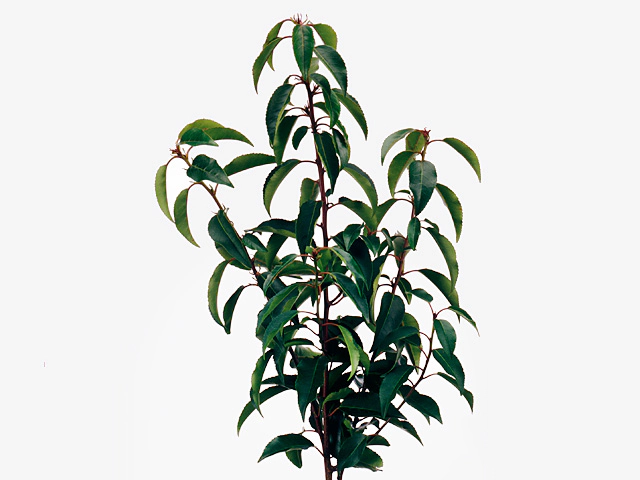Prunus (leaf) lusitanica 'Angustifolia'

| Leaf tip | Acuminate |
| Fruit type | Berry |
| Leaf margin | Dentate |
| Leaf type | Foliage leaf |
| Winter hardness | Reasonable (USDA-zone 7) |
| Leaf, general shape | Lanceolate |
| Structure (tissues) | Woody |
| Light conditions | Sunny; Semi-shades |
| Leaf division | Simple |
| Plant, growth type | Erect |
| Leaf colour, pattern | Bicolored |
| Toxicity (if consumed) | Toxic |
| Moisture requirements | Moist; Well-drained |
Prunus lusitanica 'Angustifolia', commonly known as Portuguese Laurel, is a popular evergreen shrub that is praised for its stunning foliage and its ability to thrive in various light conditions. This article will explore the characteristics and cultivation requirements of this beautiful plant.
The leaves of Prunus lusitanica 'Angustifolia' are lanceolate in shape, meaning they are long and narrow with pointed tips. The leaf margin is dentate, which refers to the teeth-like indentations along the edges of the leaf. This adds an interesting texture to the foliage. The leaves are bicolored, with a lush green upper side and a slightly lighter shade beneath.
This Portuguese Laurel variety produces small berries, adding a touch of color to the plant during the fruiting season. The fruit is classified as a berry, and although it may be tempting to consume, it is important to note that the plant is toxic if ingested. It is crucial to keep this plant away from children and pets.
Prunus lusitanica 'Angustifolia' is considered a woody plant, meaning its tissues are sturdy and durable. This contributes to the plant's winter hardiness, making it suitable for USDA hardiness zone 7. It can withstand reasonably cold temperatures and still maintain its evergreen foliage, providing year-round interest in the garden.
When it comes to light conditions, Portuguese Laurel thrives in both sunny and semi-shaded areas. It is versatile in terms of light requirements, making it an excellent choice for different areas of your garden. However, it is advisable to provide some protection from harsh midday sun in hotter regions.
In terms of growth type, Prunus lusitanica 'Angustifolia' is an erect plant, meaning it has a bushy and upright growth habit. This makes it a suitable choice for hedging or as a standalone specimen in the garden. With proper pruning, you can shape the plant to your desired form.
Moisture requirements for Portuguese Laurel are relatively easy to meet. It prefers moist, well-drained soil to thrive. It is essential to water the plant regularly, especially during dry periods, to ensure it remains healthy and vibrant.
In conclusion, Prunus lusitanica 'Angustifolia' or Portuguese Laurel is a stunning evergreen shrub with lanceolate leaves, dentate leaf margins, and bicolored foliage. It can tolerate a range of light conditions and is reasonably winter hardy. However, it is essential to be cautious of its toxicity if consumed. With the right care and attention, this plant can bring beauty and vibrancy to any garden.
Market availability index by month:
| Jan. | Feb. | Mar. | Apr. | May | Jun. | Jul. | Aug. | Sep. | Oct. | Nov. | Dec. |
|---|---|---|---|---|---|---|---|---|---|---|---|
| 4 | 4 | 4 | 3 | 2 | 1 | 1 | 1 | 1 | 3 | 3 | 3 |